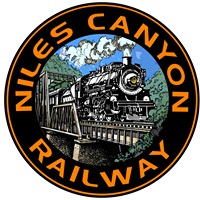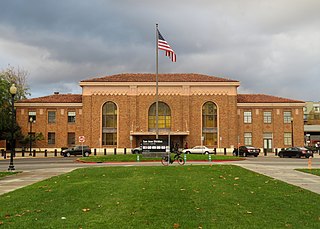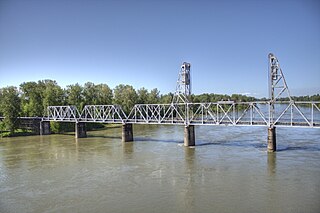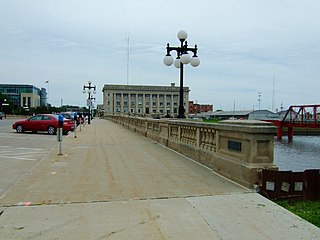
Eureka is a side-wheel paddle steamboat, built in 1890, which is now preserved at the San Francisco Maritime National Historical Park in San Francisco, California. Originally named Ukiah to commemorate the railway's recent extension into the City of Ukiah, the boat was built by the San Francisco and North Pacific Railroad Company at their Tiburon yard. Eureka has been designated a National Historic Landmark and was listed in the National Register of Historic Places on April 24, 1973.

The first Vallejo Flour Mill, in the Niles district of Fremont, California, was built in 1841 by José de Jesús Vallejo (1798–1882), elder brother of General Mariano Guadalupe Vallejo, on his Rancho Arroyo de la Alameda, along with a dam and aqueduct to power it. The Flour Mill was located at the mouth of Niles Canyon, then called Alameda Cañon, which served as the major course of Alameda Creek. A second Flour Mill was built in 1856, the stone foundation of which may still be seen today.

The Niles Canyon Railway (NCRy) is a heritage railway running on the first transcontinental railroad alignment through Niles Canyon, between Sunol and the Niles district of Fremont in the East Bay of the San Francisco Bay Area, in California, United States. The railway is listed on the National Register of Historic Places as the Niles Canyon Transcontinental Railroad Historic District. The railroad is operated and maintained by the Pacific Locomotive Association which preserves, restores and operates historic railroad equipment. The NCRy features public excursions with both steam and diesel locomotives along a well-preserved portion of the first transcontinental railroad.

San Jose Diridon station is the central passenger rail depot for San Jose, California. It also serves as a major intermodal transit center for Santa Clara County and Silicon Valley. The station is named after former Santa Clara County Supervisor Rod Diridon Sr.

The San Francisco and San Jose Railroad (SF&SJ) was a railroad which linked the communities of San Francisco and San Jose, California, running the length of the San Francisco Peninsula. The company incorporated in 1860 and was one of the first railroads to employ Chinese laborers in its construction. It opened the first portion of its route in 1863, completing the entire 49.5-mile (80 km) route in 1864. The company was consolidated with the Southern Pacific Railroad in 1870. Today, Caltrain and the Union Pacific Railroad continue to operate trains over part of the company's original route.

Santa Clara Transit Center is a railway station in downtown Santa Clara, California. It is served by Caltrain, Amtrak Capitol Corridor, and Altamont Corridor Express (ACE) trains. It is the planned terminus for the Silicon Valley BART extension into Santa Clara County on the future Green and Orange Lines. The former station building, constructed in 1863 by the San Francisco and San Jose Railroad, is used by the Edward Peterman Museum of Railroad History.

Martinez station is an Amtrak passenger train station in Martinez, California, United States. Located at the west end of downtown Martinez, the station has one side platform and one island platform, which serve three of the four tracks of the Union Pacific Railroad Martinez Subdivision. It is served by the daily California Zephyr and Coast Starlight long-distance trains, five daily round trips of the San Joaquin corridor service, and fifteen daily round trips of the Capitol Corridor service. Martinez is also served by Amtrak Thruway buses plus County Connection, Tri-Delta Transit, and WestCAT local buses.

Palo Alto station is an intermodal transit center in Palo Alto, California. It is served by Caltrain regional rail service, SamTrans and Santa Clara VTA local bus service, Dumbarton Express regional bus service, the Stanford University Marguerite Shuttle, and several local shuttle services. Palo Alto is the second-busiest Caltrain station after San Francisco, averaging 7,764 weekday boardings by a 2018 count. The Caltrain station has two side platforms serving the two tracks of the Peninsula Subdivision and a nearby bus transfer plaza.

The Union Street Railroad Bridge is a vertical lift, Pratt through truss bridge that spans the Willamette River in Salem, Oregon, United States, built in 1912–13. It was last used by trains in the early 1990s and was sold for one dollar in 2003 to the City of Salem, which converted it to bicycle and pedestrian use in 2008–2009. It was added to the National Register of Historic Places in 2006.

The Pacific Electric Railroad Bridge or Southern Pacific Railroad Bridge now officially named the "Pacific Electric Railway- El Prado Bridge" is a historic double-tracked arch bridge located in Torrance, California USA, spanning Torrance Boulevard at Bow Avenue, a short distance west of Western Avenue. It was once part of the north/south San Pedro via Gardena Line of the Pacific Electric Railway, that agency's first interurban line to San Pedro.
The Western Pacific Railroad (1862–1870) was formed in 1862 to build a railroad from Sacramento, California, to the San Francisco Bay, the westernmost portion of the First transcontinental railroad. After the completion of the railroad from Sacramento to Alameda Terminal on September 6, 1869, and then the Oakland Pier on November 8, 1869, which was the Pacific coast terminus of the transcontinental railroad, the Western Pacific Railroad was absorbed in 1870 into the Central Pacific Railroad.

The Danville Southern Pacific Train Depot in Danville, California is located at 205 Railroad Ave. and W Prospect Ave. It was built in 1891 on land donated by John Hartz which was erected when the Martinez line was extended south to San Ramon. The first train came on June 7, 1891. Passenger service ended in 1934. The Southern Pacific Railroad trains continued to pass through town with freight until 1978 when the line was abandoned. The building was sold in 1951 for the Danville Supply and Feed store. In June 1996, it was purchased and moved 100 yards.

The Civic Center Historic District is located in downtown Des Moines, Iowa, United States. It flanks both the Des Moines and Raccoon Rivers and their confluence. The district has been listed on the National Register of Historic Places since 1988. It is part of The City Beautiful Movement and City Planning in Des Moines, Iowa 1892—1938 MPS.
Walter Danforth Bliss (1874-1956) was an American architect from California. Many of his buildings are listed on the National Register of Historic Places.

Union Station is a building in Houston, Texas, in the United States. Dedicated on March 2, 1911, and formerly a hub of rail transportation, the building now serves as a cornerstone for Minute Maid Park. It is listed on the National Register of Historic Places, and has since been superseded by Houston's Amtrak station.

Rawlins station is a former train station in Rawlins, Wyoming. It was served by the Union Pacific Railroad from its 1901 construction to 1971, and Amtrak from 1971–1983 and 1991–1997. It was added to the National Register of Historic Places in 1993, as the Union Pacific Railroad Depot.

The Bayshore Cutoff is the rail line between San Francisco and San Bruno along the eastern shore of the San Francisco Peninsula. It was completed by Southern Pacific (SP) in 1907 at a cost of $7 million, and included five tunnels, four of which are still used by Caltrain, the successor to Southern Pacific's Peninsula Commute service. Fill from the five tunnels was used to build the Visitacion or Bayshore Yard, the main SP classification yard near the city of Brisbane. The Del Monte was similarly rerouted over the line at some point in its operational history.
















